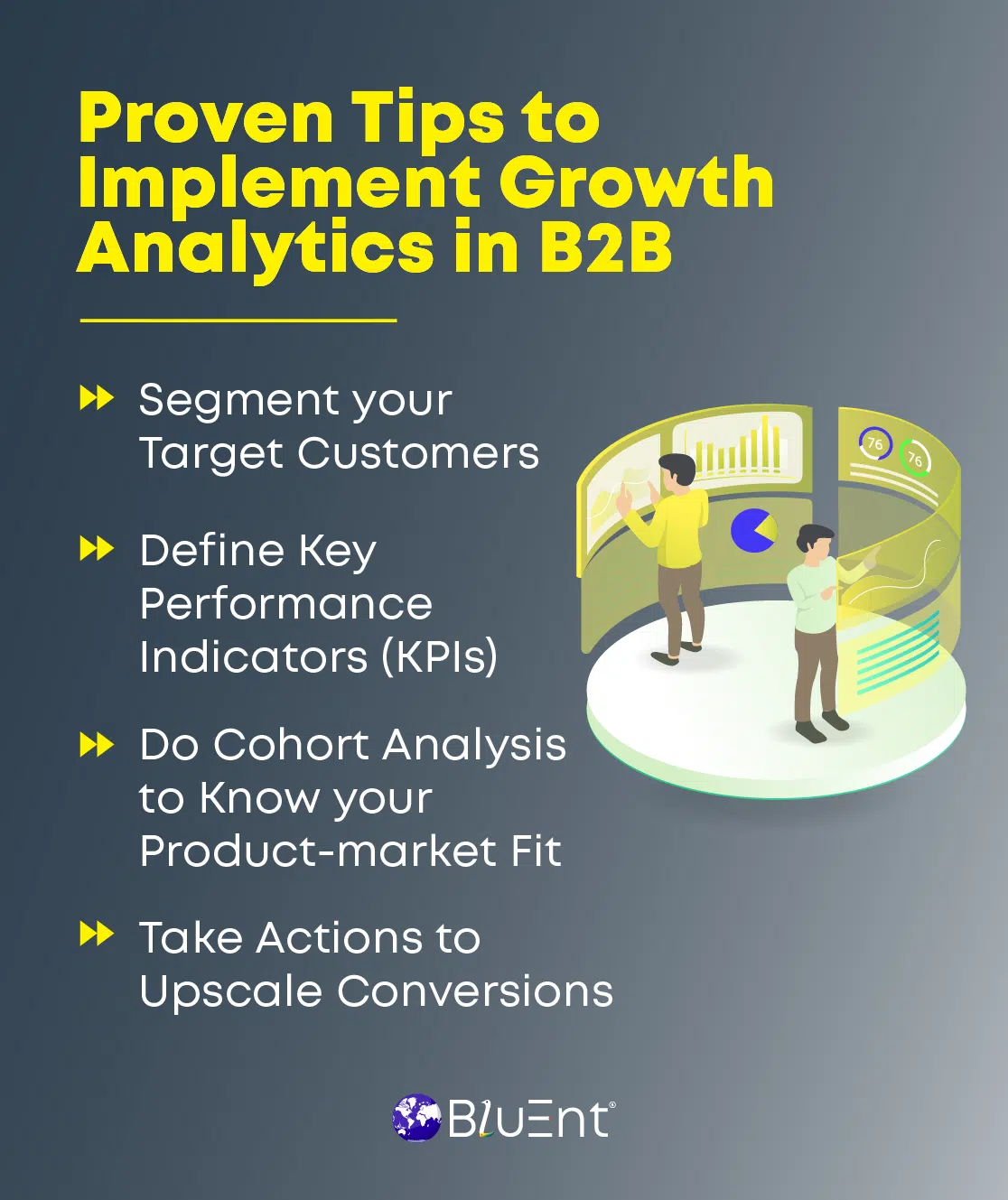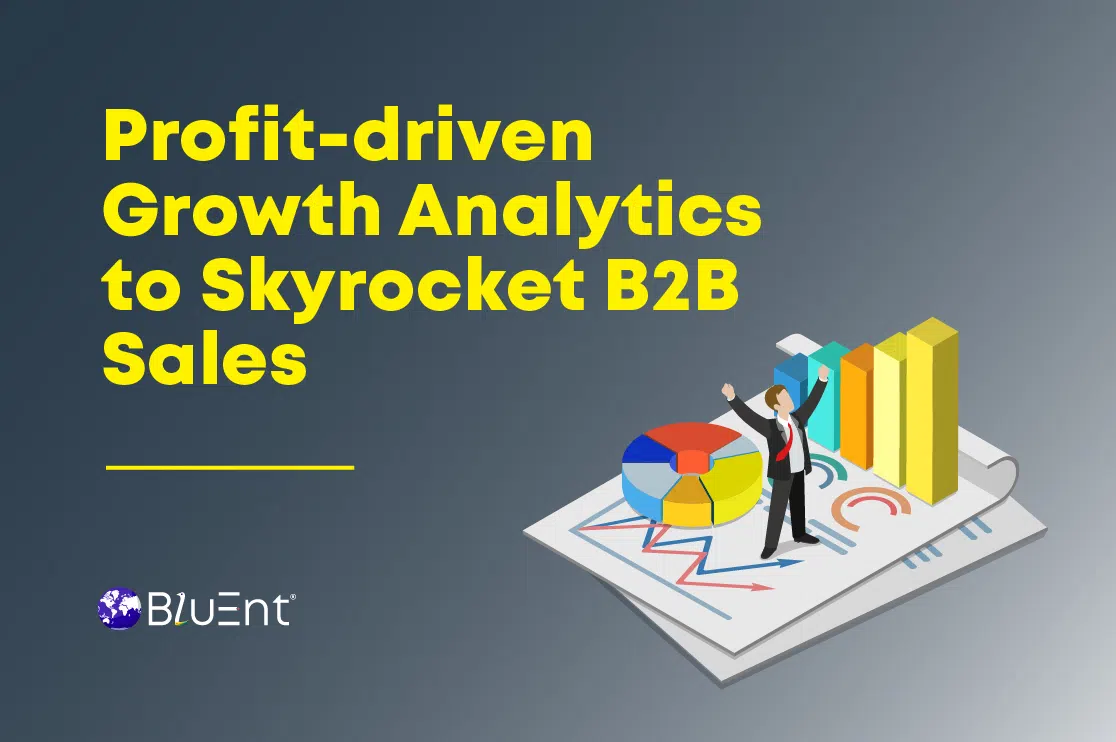This blog has been updated on - March 04, 2024
Growth Analytics is probably the most rewarding initiative to boost B2B sales, conversions, user retention, and revenue rates.
Companies using data and analytics for product sales and marketing can drive higher Return on Investments (ROIs) with the help of valuable data analytics & insights. Many B2B marketers impose data-driven approaches to evaluate their sales performance for maximum profits.
Over 73% of B2B professionals prefer to analyze each stage of their marketing plans, and more than half are the real decision-makers. Capturing and evaluating growth metrics can tell whether sales are growing or falling over time.
Are you curious to learn how growth analytics can boost your B2B sales? Let's take you through this blog to discuss:
Why your sales and marketing team should focus on growth analytics.
Which growth metrics are critical for your sales strategy?
What are the best practices to implement growth analytics?
Table of Contents:
What is Growth Analytics?
Growth analytics uses big data to measure growth metrics and gives valuable insights into sales, conversions, and other revenue-generating sources.
Product managers, growth strategists, and sales & marketing teams review revenue metrics to analyze the efficiency of their ongoing marketing campaigns. They leverage top business analytics tools and software to generate B2B sales reports and get a clear picture of their advertising outcomes.
Interestingly, UI/UX designers often require growth metrics to measure user behavior while designing a software product or app.
Most business strategists practice growth analysis to optimize their product features and performance. They capture specific metrics such as Monthly Recurring Revenues (MRR), Yearly Recurring Revenues (YRR), Cost Per Acquisition (CPA), conversions, retention, and other growth factors. In fact, customer data analytics can also be used to drive growth and profitability.

Growth Analytics for B2B Leaders: Top Reasons Explained
Growth analytics appeals to enhanced sales and profits for B2B companies. Although there are several top business analytics tools, let's see the potential factors that make it promising for your business.
Capturing and Analyzing Underlying Data Trends to Make the Best Business Decisions
Any professional sales data analytics guide refers to growth metrics for decision-making in business.
Most business strategists and product managers consider analyzing growth and loss metrics.
By collaborating with dedicated growth analysts at BluEnt, we assisted our B2B clients in:
Streamlining data integration and reporting across multiple sources or platforms in real-time.
Tracking uncertain fluctuations in the key growth trends and getting alerts.
Discovering critical growth and acquisition factors based on the latest big data analytics trends.
Recognizing the strongest and weakest points that can influence the growth metrics.
Uncovering opportunities to measure the growth parameters.
Reducing Churn Rates and Enhance Customer Experience
Getting fewer conversions is problematic not just for B2B brands but also for retailers.
Not having a solid strategy for growth analytics could be why eCommerce sites fail to convert traffic into sales, as you.
How can data analytics reduce churn rates? The growth metrics guide users to detect and fix issues blocking the conversion paths. That also includes analyzing insights from Google Analytics for digital marketing.
B2B companies can better deal with high churn rates once they determine areas influencing the customer journey. That also covers technical glitches and other underlying factors.
Defining Valuable User Cohorts to Maximize Revenue Rates
Growth metrics also leverage B2B sales data analysis to get valuable cohorts. That involves exclusive data visualization services to gain insights into customer spending patterns, product value, and other details.
Cohort analysis adds value to sales and marketing strategy for B2B companies that eventually drive revenues.
Recommended Reading:
Collect, segregate, track, manage, and integrate your sales data insights with advanced data engineering and automation.
Data Engineering ServicesKey Analytics Metrics to Prioritize for High B2B Sales
The reasons for considering growth and user acquisition analytics for B2B sales are unarguably significant. Much like predictive analytics in finance, it is also valuable for business success.
BluEnt's data analytics case study emphasizes significant analytics metrics to boost profits. Let's discuss them in brief.

Revenue Generation
It relates to revenue analytics and uses data science services to keep sales profits on track.
Revenue metrics change over time. B2B leaders can detect inconsistencies in sales growth and determine the possible reasons for using different types of data analytics.
That will help you determine:
Are you targeting the right audience?
Are your marketing campaigns interacting with users at the right time of the sales funnel?
Do you need to revise your budgeting plan?
Daily & Monthly Active Users
Paying attention to your daily and monthly active users is imperative to product growth analytics.
Usually, growth strategists use Google Analytics to improve SEO and track active users.
Monthly active users define the traffic visiting your web page or product logins every month. Daily active users outline the traffic logging into your product page or website daily.
Cost Per Lead
Are you disappointed about the high acquisition costs? Are you measuring cost per lead appropriately?
That is another critical growth metric to prioritize for B2B sales data analysis. Divide your sales and marketing expenses by the number of leads generated in the specific timeline.
Evaluating the cost per lead can help you reduce the acquisition cost when a marketing campaign is live.
Customer Retention Rate
Retaining existing customers is as important as acquiring new ones. Reports also reveal that attaining new customers is five times more expensive than keeping existing customers.
Including retention rate metrics in your growth analytics strategy makes sense. Besides applying SEO techniques for sales growth, improving retention with data analytics can grow profits by up to 95%.
Conversion Rate
This metric is critical to analyzing your B2B sales and profits. Conversion rates define the leads that turn into customers or take actions indicating purchases.
High conversion rates depend on user experience, form filling, support team efficiency, and other factors.
Churn Rate
One of the biggest challenges of B2B sales is high churn rates. Higher churn rates indicate the number of users or customers leaving a website or brand.
That also accounts for the loss in revenues and profits for any business. Hence, it could be a crucial growth metric to monitor regularly.
Upsells
Offering more than one option to the customers is a rewarding sales channel for B2B companies.
Tracking upsell metrics is a great way to gather missing sales opportunities for more revenues and profits.
Recommended Reading:
Best Practices to Leverage Growth and B2B Sales Analytics
Let's walk you through our guide to growth metrics and analytics.

Take these steps to analyze growth for high B2B sales and success.
Segment your Target Customers
At BluEnt, our team deploys advanced business analytics tools for user segmentation. We outline several criteria to segment customers, and here are they:
Varying Product usage habits
Geographic location of users
Job role and spending ability
Highly disengaged buyers or clients
Define Key Performance Indicators (KPIs)
The next step is setting up KPIs for growth marketing analytics in sales. That may include the metrics we've discussed in the last section.
Ensure your KPIs are measurable and add your goals to track KPIs for customer acquisition strategy.
Do Cohort Analysis to Know Your Product-market Fit
Focus on cohort analytics to discover more about your customers, their choices, behaviors, likes, and dislikes.
That will help you segment your customers more productively. Besides that, you can also use cohort insights to reduce churn and get a product-market fit.
Take Actions to Upscale Conversions
Cohort analysis gives a clear picture of the features you need to bring for your users. As a result, you can make changes and push your marketing campaigns in the right direction.
How is BluEnt Empowering B2B Brands with Sales-driven Growth Analytics?
B2B sales data analytics is lucrative for any business or marketing brand. As big data continues gaining significance in modern tech and digital domains, the demand for top data analytics trends and insights will grow exponentially. The data analytics job growth is already showing signs of this unprecedented demand.
Getting started with growth analytics is the need of the hour, and BluEnt is all set to accomplish that for you.
BluEnt is a trusted IT service provider, business consulting and CAD Engineering services provider with over 20 years of experience in the industry. Our expertise revolves around big data and analytics, business intelligence, business process management, enterprise mobility, CRM development, and enterprise resource planning.
Check out our portfolio to see leading brands, products, and industries we're catering to.
Ready to implement data for high B2B sales and revenues? Contact Us Now.
FAQs
Which are the most preferred tools or software for growth analytics?
Here are the top five growth analytics tools or platforms:
HubSpot
Google Analytics
Kissmetrics
Amplitude
Mixpanel
What are the challenges of growth metrics and analytics?
Most data analysts face these hurdles while measuring growth metrics for B2B brands:
Issues due to complex or unstructured data.
Lack of transparency between sales and marketing teams.
Need for more skills or expertise in growth analytics tools.





 Data Analytics in Banking: Unlocking the Potential
Data Analytics in Banking: Unlocking the Potential  Business Intelligence and Analytics: How one complements the other?
Business Intelligence and Analytics: How one complements the other?  Predictive Analytics in Finance; A Truly Transformative Idea
Predictive Analytics in Finance; A Truly Transformative Idea  Data Visualization in Finance: Telling Better Stories and Helping Make Even Better Decisions
Data Visualization in Finance: Telling Better Stories and Helping Make Even Better Decisions 
